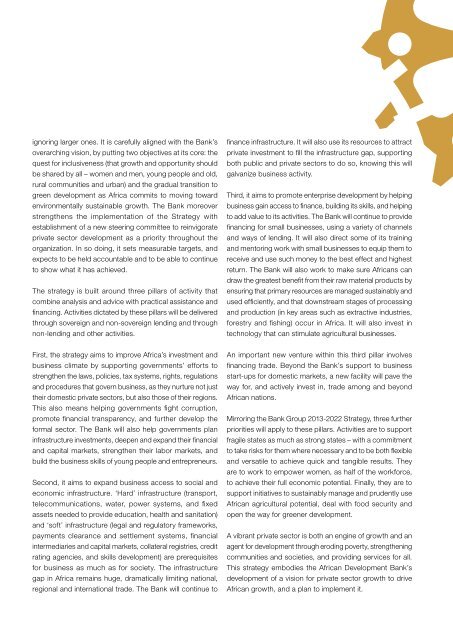2013-2017_-_Private_Sector_Development_Strategy
2013-2017_-_Private_Sector_Development_Strategy
2013-2017_-_Private_Sector_Development_Strategy
You also want an ePaper? Increase the reach of your titles
YUMPU automatically turns print PDFs into web optimized ePapers that Google loves.
ignoring larger ones. It is carefully aligned with the Bank’s<br />
overarching vision, by putting two objectives at its core: the<br />
quest for inclusiveness (that growth and opportunity should<br />
be shared by all – women and men, young people and old,<br />
rural communities and urban) and the gradual transition to<br />
green development as Africa commits to moving toward<br />
environmentally sustainable growth. The Bank moreover<br />
strengthens the implementation of the <strong>Strategy</strong> with<br />
establishment of a new steering committee to reinvigorate<br />
private sector development as a priority throughout the<br />
organization. In so doing, it sets measurable targets, and<br />
expects to be held accountable and to be able to continue<br />
to show what it has achieved.<br />
The strategy is built around three pillars of activity that<br />
combine analysis and advice with practical assistance and<br />
financing. Activities dictated by these pillars will be delivered<br />
through sovereign and non-sovereign lending and through<br />
non-lending and other activities.<br />
finance infrastructure. It will also use its resources to attract<br />
private investment to fill the infrastructure gap, supporting<br />
both public and private sectors to do so, knowing this will<br />
galvanize business activity.<br />
Third, it aims to promote enterprise development by helping<br />
business gain access to finance, building its skills, and helping<br />
to add value to its activities. The Bank will continue to provide<br />
financing for small businesses, using a variety of channels<br />
and ways of lending. It will also direct some of its training<br />
and mentoring work with small businesses to equip them to<br />
receive and use such money to the best effect and highest<br />
return. The Bank will also work to make sure Africans can<br />
draw the greatest benefit from their raw material products by<br />
ensuring that primary resources are managed sustainably and<br />
used efficiently, and that downstream stages of processing<br />
and production (in key areas such as extractive industries,<br />
forestry and fishing) occur in Africa. It will also invest in<br />
technology that can stimulate agricultural businesses.<br />
First, the strategy aims to improve Africa’s investment and<br />
business climate by supporting governments’ efforts to<br />
strengthen the laws, policies, tax systems, rights, regulations<br />
and procedures that govern business, as they nurture not just<br />
their domestic private sectors, but also those of their regions.<br />
This also means helping governments fight corruption,<br />
promote financial transparency, and further develop the<br />
formal sector. The Bank will also help governments plan<br />
infrastructure investments, deepen and expand their financial<br />
and capital markets, strengthen their labor markets, and<br />
build the business skills of young people and entrepreneurs.<br />
Second, it aims to expand business access to social and<br />
economic infrastructure. ‘Hard’ infrastructure (transport,<br />
telecommunications, water, power systems, and fixed<br />
assets needed to provide education, health and sanitation)<br />
and ‘soft’ infrastructure (legal and regulatory frameworks,<br />
payments clearance and settlement systems, financial<br />
intermediaries and capital markets, collateral registries, credit<br />
rating agencies, and skills development) are prerequisites<br />
for business as much as for society. The infrastructure<br />
gap in Africa remains huge, dramatically limiting national,<br />
regional and international trade. The Bank will continue to<br />
An important new venture within this third pillar involves<br />
financing trade. Beyond the Bank’s support to business<br />
start-ups for domestic markets, a new facility will pave the<br />
way for, and actively invest in, trade among and beyond<br />
African nations.<br />
Mirroring the Bank Group <strong>2013</strong>-2022 <strong>Strategy</strong>, three further<br />
priorities will apply to these pillars. Activities are to support<br />
fragile states as much as strong states – with a commitment<br />
to take risks for them where necessary and to be both flexible<br />
and versatile to achieve quick and tangible results. They<br />
are to work to empower women, as half of the workforce,<br />
to achieve their full economic potential. Finally, they are to<br />
support initiatives to sustainably manage and prudently use<br />
African agricultural potential, deal with food security and<br />
open the way for greener development.<br />
A vibrant private sector is both an engine of growth and an<br />
agent for development through eroding poverty, strengthening<br />
communities and societies, and providing services for all.<br />
This strategy embodies the African <strong>Development</strong> Bank’s<br />
development of a vision for private sector growth to drive<br />
African growth, and a plan to implement it.


